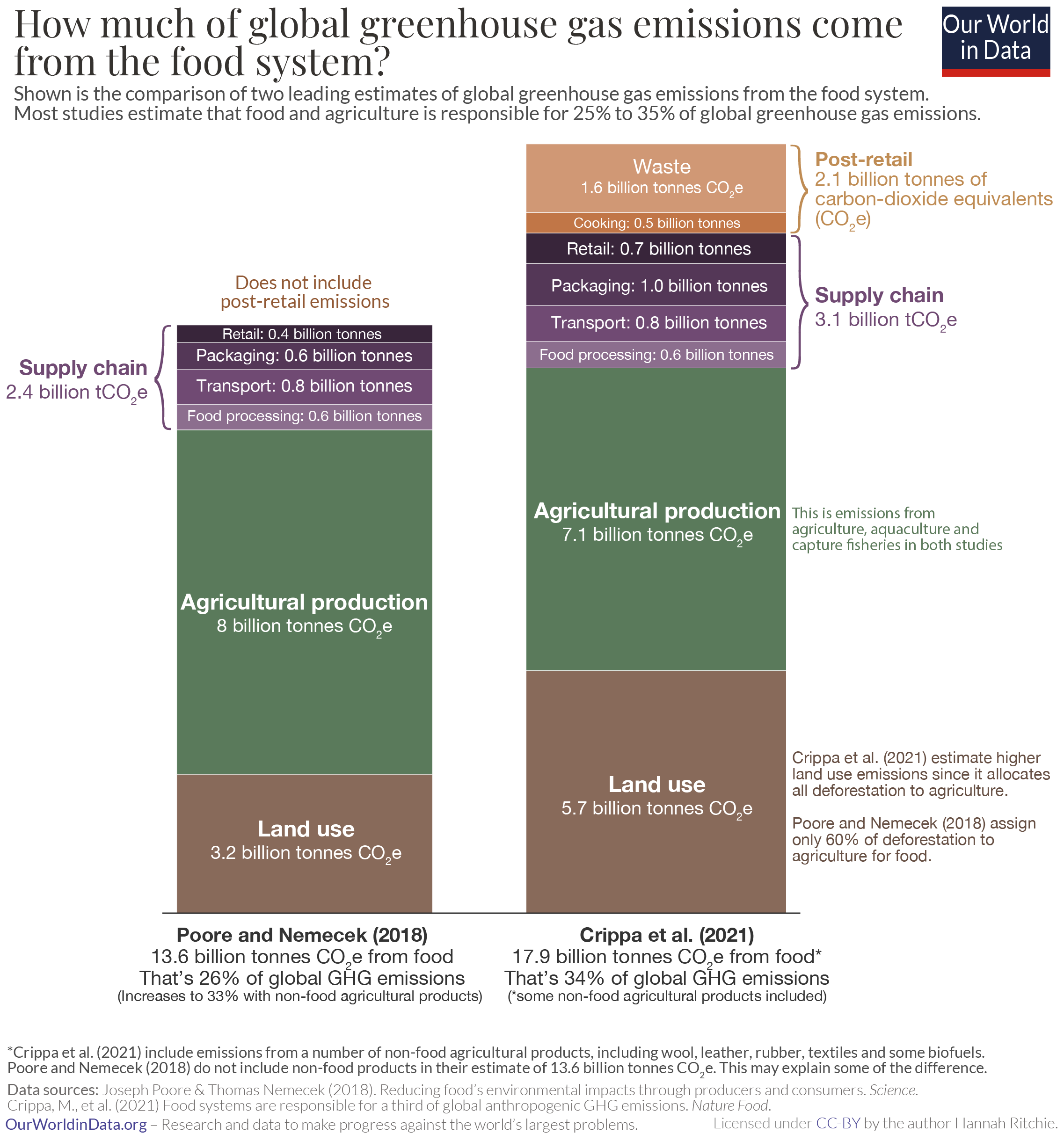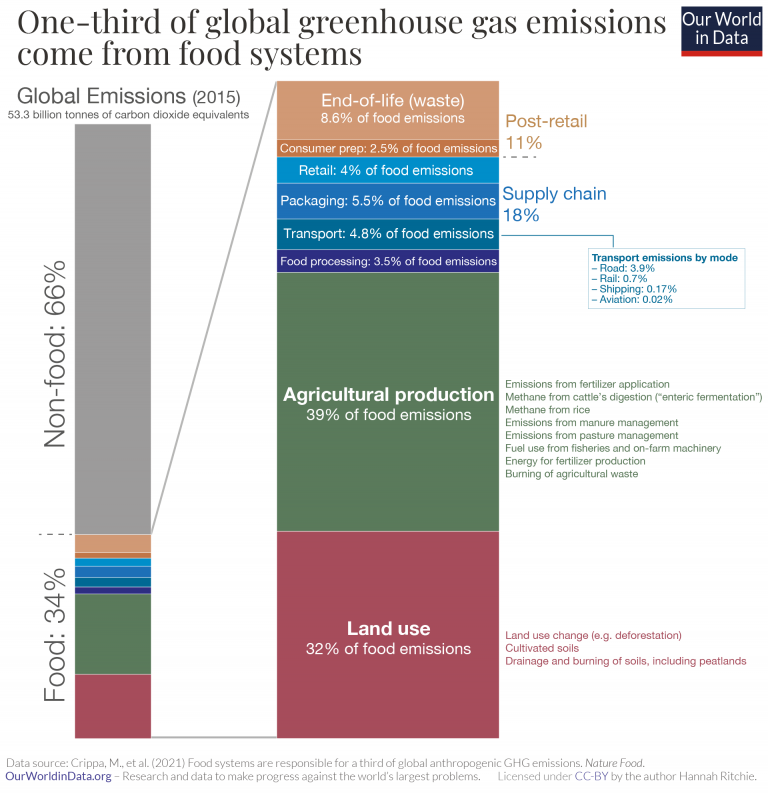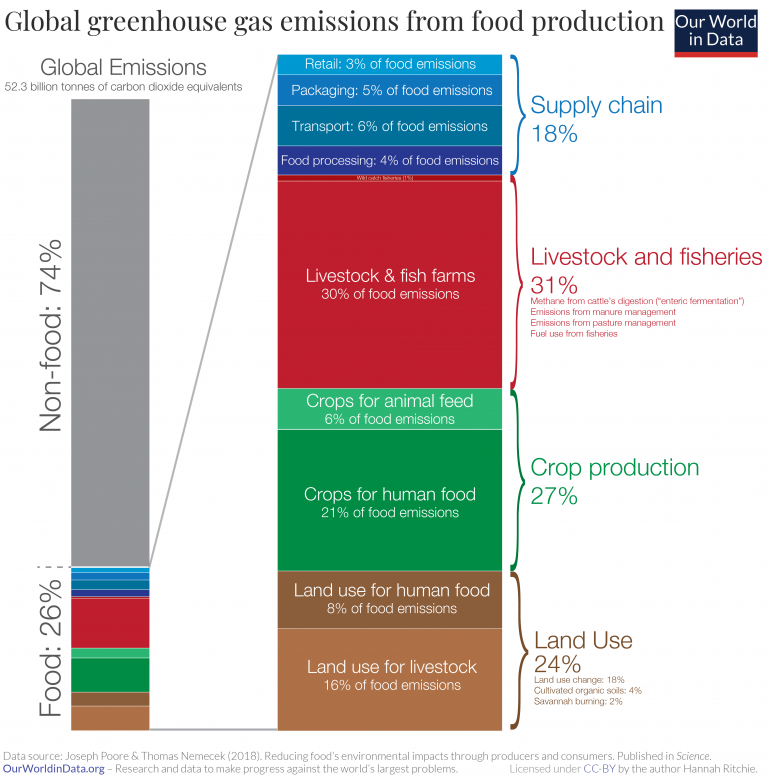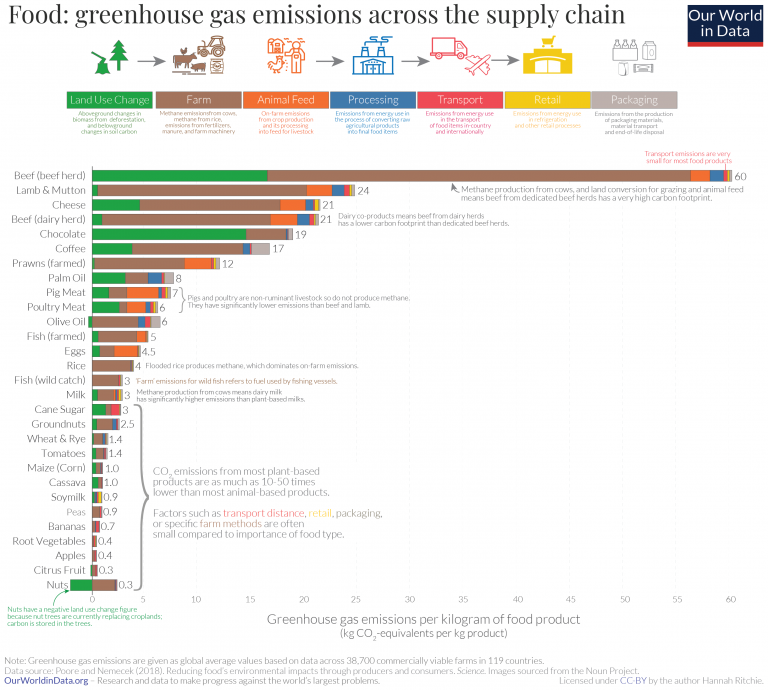Summary
There are a wide range of estimates for how much of the world’s total greenhouse gas emissions come from food. Some studies say this figure is one-quarter, some say it’s more than one-third.
Where do these differences come from? There are three reasons why some of these estimates vary so much:
1) some studies do not include emissions from cooking and food waste;
2) different studies disagree about the emissions from land use change and deforestation;
3) some, but not all, studies include non-food agricultural products such as cotton, wool, leather and biofuels
The specific number that answers this question depends on these three factors, but the range of possible answers is not too large: around 25% to 30% of global emissions come from our food systems, and this rises to around one-third when we include all agricultural products.
People are becoming increasingly aware that their diet comes with a climate cost. But just how much of our greenhouse gas emissions comes from food?
In a previous article I looked at where greenhouse gas (GHG) emissions in the food system came from – ranging from deforestation and land use, through to transport and packaging. The study my article was based on was published by Joseph Poore and Thomas Nemecek, estimated that the food system was responsible for one-quarter (26%) of global emissions.1 A new study, published by Monica Crippa and colleagues in Nature Food estimates a higher share: one-third (34%) of emissions.2
In this article I want to explain where the differences in these estimates come from. You can explore the results of the study by Crippa et al. (2021) on our work on the Environmental impacts of food here.
One-quarter or one-third: how much of global emissions come from food?
It is nothing new that estimates of food emissions span a wide spectrum. The Intergovernmental Panel on Climate Change (IPCC) Special Report on Climate Change and Land reports a range from 10.8 and 19.1 billion tonnes of CO2-equivalent (CO2e) emissions per year.3 That’s between 21% to 37% of global total emissions. Quite a big difference. We’ll soon see where these disagreements come from.
In light of this, the difference in estimates from Poore and Nemecek (2018) of one-quarter, and Crippa et al. (2021) of one-third are not that surprising. They fall right in the middle of this wide range. Given that they are using very different methods to get to these numbers it is actually encouraging, from a research perspective, that these estimates are so close to each other. But we should still try to figure out where the differences come from.
In the chart here I’ve shown the results of these two studies side-by-side. I’ve grouped emissions into their comparable parts of the food chain:
- Land use: this includes deforestation, peatland degradation and fires, and emissions from cultivated soils.
- Agricultural production: this includes emissions from synthetic fertilizers (and the energy used to manufacture them); manure; methane emissions from livestock and rice; aquaculture; and fuel use from on-farm machinery.
- Supply chain: this includes all emissions from food processing, packaging, transport, and retail, such as refrigeration.
- Post-retail: this is all the energy used by consumers for food preparation, such as refrigeration and cooking at home. It also includes emissions from consumer food waste.
Poore and Nemecek, shown on the left, estimated that food was responsible for 13.6 billion tonnes of CO2e. Crippa et al. estimate 17.9 billion tonnes of CO2e. So, there’s a difference of around 4 billion tonnes. Where does it come from?
- Consumer cooking and waste are not always included in Poore and Nemecek: the easiest differrence to spot is that Poore and Nemecek only quantify emissions up to the retail stage of the supply chain. They don’t include energy use by consumers or consumer waste. As we see from the chart, this amounts to 2.1 billion tonnes CO2e.
- Land use emission estimates differ: the biggest difference is in land use emissions. Crippa et al. (2021) estimate emissions to be 2.5 billion tonnes CO2e higher. This can be largely explained by differences in the attribution of deforestation. They allocate all of global deforestation to agriculture. However, the authors note that this is a main limitation of their approach, since only around 80% of deforestation is driven by agricultural expansion (the rest driven by urban development, mining and other human land use change). So their deforestation estimate is possibly a bit too high. Poore and Nemecek only allocated 60% of deforestation to food systems. This might be a bit of an underestimate. Land use emissions due to agriculture are likely to be somewhere in the middle of these two values.
- Food vs. non-food agricultural products: the other main difference is that Poore and Nemecek only include food products in their 13.6 billion tonnes CO2e figure. Non-food agricultural products such as cotton, wool, leather, rubber and biofuels are not included. They do also provide a separate estimate which includes non-food products; this estimates that agricultural products as a whole contributes 33% to global emissions. Crippa et al. (2021) do include at least some of these non-food agricultural products in their estimate.
Comparing these two studies is useful because they highlight the main differences we see across the range of studies on food emissions. The big differences are: what stages of the supply chain are covered (some studies include consumer cooking and waste, some don’t); whether non-food agricultural products such as biofuels and textiles are included; and the biggest uncertainty is emissions from deforestation and land use change. The uncertainty in deforestation emissions estimates from the UN FAO can be as high as 50%, and over 100% for emissions from peatlands.4 Deforestation can also vary a lot from year-to-year, so decadal average values are often used.
How much of global greenhouse gas emissions come from food systems? The amount of uncertainty in these estimates means it’s helpful to understand where the differences come from, and that they all fall within a reasonably narrow range. If someone asks me, my response is usually “around 25% to 30% from food. Around one-third if we include all agricultural products.”



